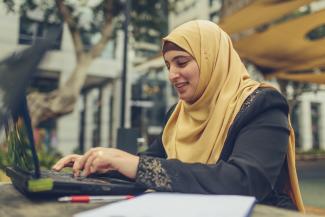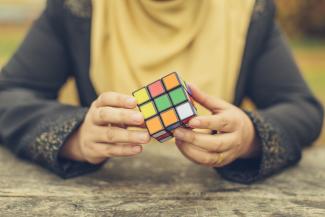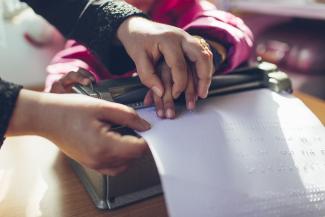Amani's Big Idea
A Palestinian inventor takes on the world
Story by Kelly Ramundo, USAID and Sahar Kalifa, USAID | Photos and Video by Bobby Neptune and Brian Hill for USAID
June 2016

The little inventor
From the time she was a little girl in East Jerusalem, Amani Amani Abu Tair showed no interest in dolls or toys like other children.
“I didn’t care about Barbies,” says the 25-year-old student and engineer. “I wanted to open the radio, I wanted to open the TV.”
When she was 9, she wanted a scooter so she decided to build her own with wood she collected and two wheels: “Everyone was calling me the little inventor.”
This fascination with how things work persisted into adulthood.
In her twenties, Amani started designing apps and games.
She created an app to track doctors’ hospital shifts and another to teach kids about nutrition.
Driving her inventions was a desire to fix deficiencies she saw in the world around her.



Two years ago, Amani had an epiphany.
She was sitting in mechanics class listening to the teacher describe a difficult lesson.
“I thought: ‘Oh my God, this is really hard. I can’t understand it even though I can see and hear everything.’”
Amani suddenly wondered: “What about blind people? How can they learn?”
From that moment, Amani was obsessed.
She sought out schools for blind children in the West Bank and East Jerusalem and began to study how the students learned.
She noticed one problem immediately: The machine most children used to learn braille, the written language of the blind, was riddled with difficulties for the small learners.

The typewriter-like machine was first manufactured in the 1950s and is still widely used to teach braille in many parts of the world.
Though road-tested, Amani noticed that it was too large for students to carry on their own. Their small hands often struggled with the keys.



“I must find a better way!”
She also realized that the device was not conducive to independent learning. Children could only use it with a teacher guiding them, and it was too expensive for their parents to buy.
“This is really a huge problem,” Amani says. “When they go home, they can’t have anyone around them to teach them.”
“So, because I’m an engineer, and I believe that education is right for all, I said ‘I must find a better way.’”
Amani set out to invent an alternative.
Before long, she had a prototype of the Braille FMZ — a small, mechanical device that uses voice instruction and mechanical dots that rise and fall to depict the braille alphabet under a child’s fingers.
“It took me one week to program the whole device—everything into multiple languages. I couldn’t sleep. I was hugging the device all the time. I treated it as my little baby,” she says.


Today she is seeking support to manufacture it at scale.
The master’s degree in business administration she is pursuing at Technion University in Tel Aviv is meant to help with that.
So will sheer determination.
“When I have an idea I can’t sleep,” she says. “I will do market research, I will make sure there is a need for this device, and it solves problem, deliver a value, and I can build it on my own.”


Amani’s determination doesn’t stop with her most recent invention. “I want to be the most successful social entrepreneur in the whole world,” she says. “And when you want to measure my success, my success will be how much I can help other people around me.”
About This Story
Amani is one of 14,000 young people who USAID has supported through its Youth Entrepreneurship Development Project, which helps Palestinian youth find jobs and create their own businesses. The project develops career centers at local universities and helps students with career guidance, technical training and internships.
In 2012, USAID provided Amani intensive training on entrepreneurship and business-plan development through Palestine Polytechnic University.
A year later, she was one of 30 Palestinian students who, with USAID support, participated in a mini-MBA program at Tel Aviv University in partnership with the Kellogg School of Management.
Additionally, in June 2016, Amani was one of 700 global entrepreneurs chosen to travel to Silicon Valley to seek support for their innovations at the U.S. Government-sponsored Global Entrepreneurship Summit.




